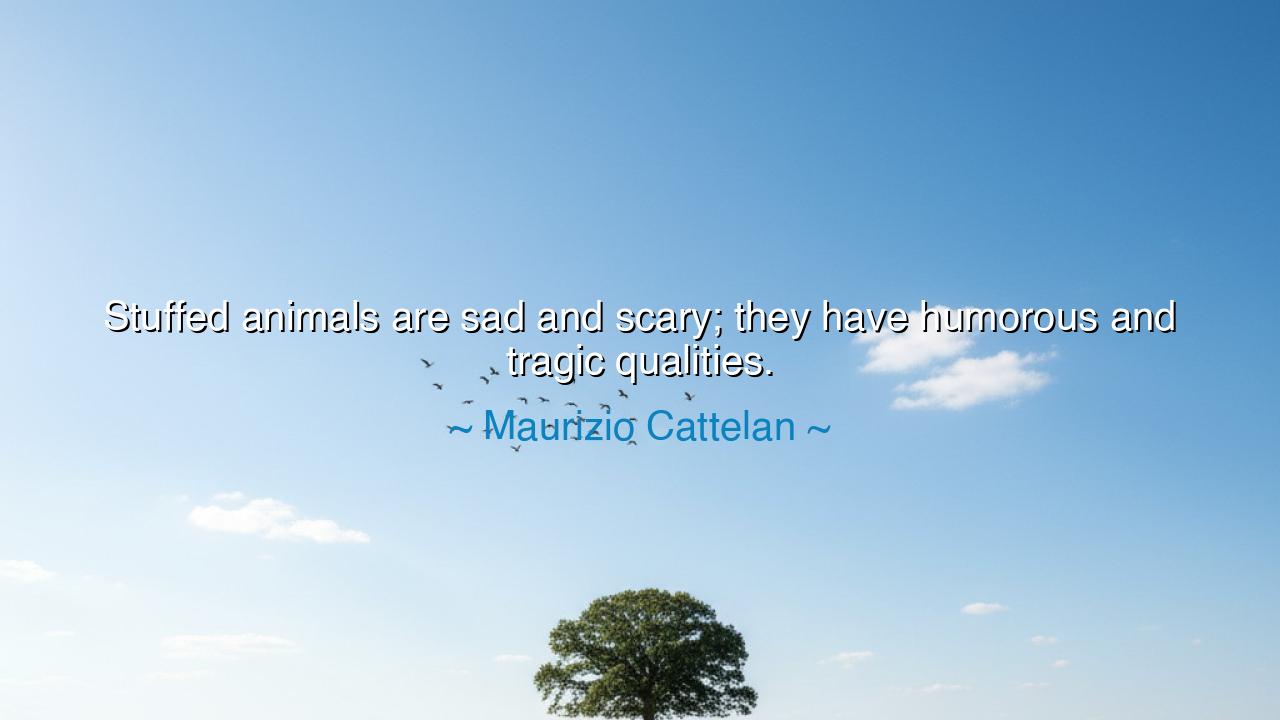
Stuffed animals are sad and scary; they have humorous and tragic






There is a strange and haunting wisdom in the words of Maurizio Cattelan, who said, “Stuffed animals are sad and scary; they have humorous and tragic qualities.” In this simple yet profound reflection, the artist reveals his gift for seeing the hidden paradoxes of life — the way beauty and sorrow, laughter and fear, coexist within the same moment. To the unthinking eye, a stuffed animal may be nothing more than a preserved creature, a relic of childhood or of taxidermy. But to the wise, it is a symbol — a mirror of the human condition itself: lifelike yet lifeless, beloved yet artificial, comic in form but tragic in essence. Cattelan, known for his provocative art, uses this image to remind us that much of what we love and celebrate carries within it the shadow of loss.
The origin of this quote comes from Cattelan’s long exploration of death, absurdity, and irony in modern existence. His works — a horse hanging from the ceiling, a squirrel seated at a table as if in mourning, a taxidermied dog in prayer — are not meant to horrify, but to awaken. He invites us to look at the familiar and see the truth beneath the surface. In the stuffed animal, he sees the contradiction of the modern soul: we cling to life even as we destroy it, we preserve the appearance of what we love but lose its essence. What we think is humorous — a toy, a decorative object — is also tragic, for it reminds us of what once lived and breathed but no longer does.
The ancients, too, understood this dance between comedy and tragedy. The philosopher Heraclitus said that the universe is a harmony of opposites — that joy and sorrow are not enemies, but twins. When Cattelan calls stuffed animals both “sad and scary,” he speaks in the same spirit: that the world’s beauty is inseparable from its fragility. Just as laughter can erupt in the midst of tears, so too can humor arise from death’s shadow. The stuffed animal — forever smiling, forever still — becomes a metaphor for humanity’s attempt to defy mortality while being constantly reminded of it.
One might think of the ancient Egyptians, who mummified their dead with reverence and adorned them with gold and jewels. To them, this was not grotesque but sacred — an effort to hold onto the form of life, even when the soul had departed. Cattelan’s vision is the modern echo of that same longing. We no longer build pyramids; instead, we preserve the familiar — toys, memories, photographs — trying to capture eternity in fragile material. Yet, in doing so, we often reveal our deepest fear: that everything we love will fade, and that imitation cannot replace essence. The stuffed animal, then, is not just a child’s comfort but a symbol of the adult’s sorrow — a reminder that all preservation is also admission of loss.
There is also humor in this tragedy, for the human heart cannot face despair without finding absurdity in it. When Cattelan sees the stuffed animal as both funny and tragic, he touches on the oldest truth of art — that laughter is often born from pain. Consider Charlie Chaplin, who turned poverty and suffering into comedy. His tramp character, with a flower in his lapel and holes in his shoes, is both ridiculous and noble. Like Cattelan’s stuffed creatures, Chaplin’s tramp makes us smile even as we ache. This mixture of the comic and the melancholic is the essence of being alive: we laugh at what hurts us because to laugh is to resist despair.
Cattelan’s reflection is also a commentary on modern humanity — on how we decorate death and disguise decay with beauty. The stuffed animal stands as a monument to this illusion: we make lifeless things seem living, and living things seem artificial. In our obsession with surfaces, we risk losing contact with the real — with nature, emotion, and the fleetingness of existence. Yet, paradoxically, it is through confronting this artificiality that we might rediscover truth. To look at something sad and still find it beautiful is not cynicism; it is wisdom. It means we have learned to see the full circle of existence, the balance between what ends and what remains.
The lesson, my children, is this: do not fear the mixture of joy and sorrow, beauty and decay. Life itself is both stuffed and breathing, tragic and humorous, finite and eternal. Learn to see both sides, and you will not be deceived by either. Do not cling to what is only appearance, but neither reject what gives comfort. Cherish what lives, but understand that death, too, has meaning. When you behold the strange and the sorrowful, look deeper — there, within the sadness, you will find laughter; within the absurd, you will find truth.
For as Maurizio Cattelan teaches us, art — and life — are mirrors of contradiction. The stuffed animal stands before us as a silent prophet: it tells us that what we preserve is never the flesh, but the feeling; not the body, but the memory. To live wisely is to hold both the tragic and the humorous in your heart at once — to weep and to smile, knowing that each completes the other. And when you can look upon something both sad and beautiful, and still find reverence in it, then you have learned what it truly means to be alive.






AAdministratorAdministrator
Welcome, honored guests. Please leave a comment, we will respond soon